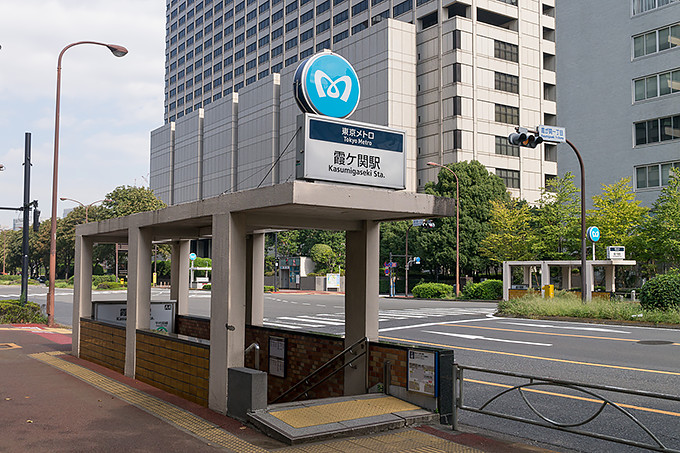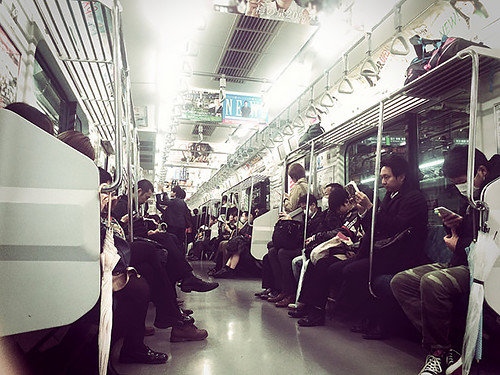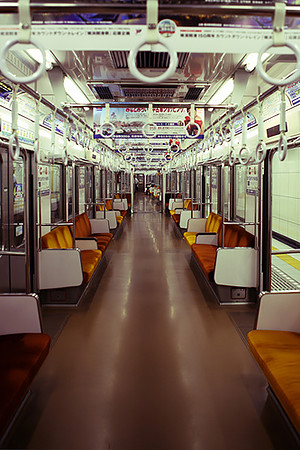
Jolyon Baraka Thomas
There is nothing quite so touching (or quite so irritating) as having a total stranger slump against you in a deep sleep on a Tokyo train.
Like the Internet, Tokyo trains are equally intimate and anonymous. They are spaces where one encounters fellow Tokyoites in all their wacky fashion, their frenetic mobile phone gaming, their inane conversations, their drunken abandon. Tokyo trains are raucous in the evenings and eerily silent during the day. They are often uncomfortably crowded, but they are nevertheless a place to temporarily let down one’s guard. I’ve actually boarded the Yamanote circle line and ridden it all the way around the city just so I could sneak in an hour-long nap.
This is not to say that Tokyo trains are without their unique challenges. It is true that at some stations during rush hour white-gloved station attendants push commuters onto crowded trains. It is also true that salarymen pass out in awkward positions after nights of hard drinking. Although it is increasingly rare, women are felt up on crowded trains. People use trains as immense blunt objects with which to commit very public suicides. Euphemisms distance passengers from these uncomfortable realities of their commutes: a delay may be due to a “human body accident,” which could simply mean that a high school student got her hand stuck in a closing door, but could also signify a grislier event that necessitates a deep cleaning of the tracks.
But above all, the train is safe. It is this sense of safety that allows strangers to slump against one another in deep sleep, rocked into complacency by the gentle rhythm of the wheels on the tracks, the lullaby of conductors’ softly worded announcements, and the melodious tinkle of station boarding chimes.

On the train, people’s bags are often gaping open, revealing wallets and cutting-edge electronics that are rarely stolen. Strangers inform a fellow commuter when she drops her precious commuter pass or is about to leave her umbrella behind. People return valuables to station attendants: mobile phones, envelopes bulging with wads of cash. In the rare event that someone is being harassed, passengers will intervene. I once saw a group of mild-mannered gentlemen gently but firmly direct a Japanese salaryman off the train and onto the platform because he was spewing racist invective at a mild-mannered foreigner who was quietly minding his own business. On the train people have your back, even if that often means that they are standing back-to-back with you and it is August and you can feel drops of their sweat mingling with your own.
Trains are also the sites of the most noteworthy act of domestic terrorism in Japan: the March 20, 1995 sarin gas attack perpetrated by the religious group Aum Shinrikyō. Convinced that police investigation of Aum in connection with high-profile murders and abductions represented final proof that an antagonistic Japanese society was beyond all hope of redemption, Aum’s leadership adopted a final solution designed to protect Aum from the forces they thought were conspiring to undermine the group’s sacred mission. Five elite members of the rigidly hierarchical organization boarded trains converging on Kasumigaseki Station in central Tokyo armed with bags of liquid sarin that they had produced in Aum’s makeshift chemical laboratories. They punctured the bags with sharpened umbrellas, quickly debarked, and let the evaporating liquid do its deadly work in the confined spaces of Tokyo’s trains and tunnels. Ultimately twelve people died, hundreds were seriously injured with life-long physical symptoms and psychological trauma, and thousands of Tokyo commuters were otherwise affected.
The material infrastructure of Tokyo’s labyrinthine train system is therefore subtly, but palpably, linked to the most striking religious incident in recent history and—by extension—to Japanese conceptions of religion. This is not to say that every Tokyoite who boards the Ōedo Line automatically thinks of Aum. Indeed, it is more likely that she will focus on curling her eyelashes just so while using her mobile phone camera as a compact, or that he will avidly read the latest issue of Morning manga magazine.
But the reminders are everywhere, both in presence and in absence. Posters with the Japanese equivalent of “If you see something, say something” are ubiquitous. Train stations are impeccably clean, but garbage cans are rare. Most were removed as an anti-terrorism measure after beleaguered Aum members attempted to spread cyanide gas in Shinjuku—the busiest train station in the world—on May 5, 1995.
Tokyo trains therefore serve as a sort of mobile anti-monument. The tracks and the carriages were not constructed for the express purpose of memorialization, but they nevertheless carry the memory of Aum’s violence and victims.
The obvious grandeur of Meiji Shrine will catch the eye of the foreign tourists who pair a visit to its serene grounds with a walk down the chaotic jumble of Takeshita Doori (a popular shopping street in nearby Harajuku). With its massive torii, wide graveled walkways, solemn wedding processions, and seemingly endless racks of ema votive plaques, Meiji Shrine is perhaps the most imposing religious edifice in Tokyo proper.
But for the Tokyoite, the Chiyoda Line train that gets one to the shrine’s immediate vicinity may call religion to mind just as the shrine itself does. As one of Aum’s targets in March 1995, that train is as much a site for religious memory as is the shrine. The difference is that one was constructed in the early twentieth century to apotheosize a recently deceased emperor; the other less deliberately, but nevertheless palpably, serves as a traveling physical memorial to the dead and injured victims of Aum’s atrocious attack.

Commemoration therefore happens in both positive and negative ways in the material culture of Japan’s largest city. Religious statuary and steles are everywhere, nestled between Tokyo’s architecturally ugly (but seismically sound) buildings of reinforced concrete. Such monuments are part of residents’ lives even if the incidents or individuals they commemorate are no longer recalled in anyone’s living memory, and even if the people who maintain them or make offerings to them would not identify as particularly religious. The controversial Yasukuni Shrine—Japan’s shrine to the deified war dead that has been getting some press attention this year as the world marks the 70th anniversary of the close of the Pacific War—serves as a focal point for Japanese citizens to recall wartime sacrifices for the nation. Roadside shrines, statues, and carefully maintained graveyards adjacent to Buddhist temples serve as focal points for positive commemoration. They are set aside as places to remember what might otherwise be forgotten.
But a different sort of commemoration happens in the labyrinthine network of subways and public and private rail lines that famously makes the map of Tokyo look like a bowl of soba noodles. Every time one boards the train, Aum’s insistent demand that Japanese people convert or die is felt. Each time one passes through a station, one cannot help but recall Aum’s victims, if only vaguely or subconsciously.
It is true that people are safe on the train. They sleep. Parents let their young children ride the train alone to after school lessons at private academies (juku). People relax on the train, loosening their ties between one appointment and the next. But beneath it all, intermingled with the thrum of wheels on rails and the whoosh of entering and exiting tunnels, is a quiet anxiety that is linked to religion. Even as one spots the unmistakable tiled roof of a temple from the vantage point of the elevated Tōyoko Line, even as one passes a small roadside shrine (hokora) on her way home from the station, these ubiquitous physical reminders of religion as a relatively benign presence are counterbalanced by a sprawling transportation infrastructure that insistently whispers of a religion that screams. A religion that kills. A religion that makes the quotidian banality of the commuter experience always-already under threat.
Using public transport in contemporary Tokyo therefore becomes a sort of training. Boarding the train—a nearly inescapable experience in the city—creates a sense of normalcy against which an implied religious threat is always-already present. Religion is something outside that threatens to intrude. It must be held at bay. The injunctions to say something if one sees something serve as a reminder of religion’s threatening presence.
In this way, the train does not merely help people get to religious sites like shrines and temples. It also brings religion to them.
Jolyon Baraka Thomas is Assistant Professor of East Asian Languages and Civilizations at the University of Pennsylvania, where he teaches courses on Japanese religion, pop culture, and history. His research covers topics such as the politics of religious freedom, religion and media, and relationships between religion, sex, and gender. Jolyon is also Editor of Asian Traditions at the Marginalia Review of Books. He can be followed @jolyonbt.
